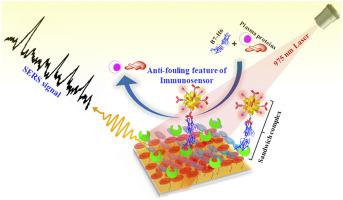当前位置:
X-MOL 学术
›
Anal. Chim. Acta
›
论文详情
Our official English website, www.x-mol.net, welcomes your feedback! (Note: you will need to create a separate account there.)
Anti-fouling SERS-based immunosensor for point-of-care detection of the B7-H6 tumor biomarker in cervical cancer patient serum
Analytica Chimica Acta ( IF 6.2 ) Pub Date : 2020-11-01 , DOI: 10.1016/j.aca.2020.09.019 Sandeep Surendra Panikar , Nehla Banu , Jesse Haramati , Gloria Yareli Gutierrez-Silerio , Blanca Estela Bastidas-Ramirez , Martha Cecilia Tellez-Bañuelos , Tanya A. Camacho-Villegas , Susana del Toro-Arreola , Elder De la Rosa
Analytica Chimica Acta ( IF 6.2 ) Pub Date : 2020-11-01 , DOI: 10.1016/j.aca.2020.09.019 Sandeep Surendra Panikar , Nehla Banu , Jesse Haramati , Gloria Yareli Gutierrez-Silerio , Blanca Estela Bastidas-Ramirez , Martha Cecilia Tellez-Bañuelos , Tanya A. Camacho-Villegas , Susana del Toro-Arreola , Elder De la Rosa

|
Herein, we report the development of sandwich type Surface Enhanced Raman Spectroscopy (SERS) immunosensor modified to be zwitterionic for the detection of soluble B7-H6 biomarker in blood serum from cervical cancer patients. Anti-fouling capture SERS substrate of biosensor based on gold (Au) thin film was modified with a self-assembled monolayer of zwitterionic l-cysteine to combat serum fouling and was then conjugated with NKp30 receptor protein to capture the B7-H6 biomarker in blood serum. The SERS nanoprobe based on spiky gold nanoparticles (AuNPs) was functionalized with ATP reporter molecule, that is stable at a wide range of pH, making the SERS signal reliable in complex media. Then, it was conjugated with anti-B7-H6 antibody forming the complex anti-B7-H6@ATP@AuNPs (i.e., SERS nanoprobe). The proposed immunosensor demonstrated high reproducibility for the quantitative detection of soluble tumor biomarker B7-H6 within the range of 10-10 M to 10-14 M with limit of detection (LOD) of 10-14 M or 10.8 fg mL-1, in the cancer patient serum, greatly exceeding (100 fold) the LOD of commercially available ELISA kits. Such low LOD is partially the result of zwitterionic modification which reduces the serum fouling by 55% compared to traditionally used BSA blocked capture substrates (i.e., control). Notably, this immunosensors demonstrated higher accuracy for detecting the B7-H6 biomarker in undiluted blood serum samples from cervical cancer patients and outperforms the currently available analytical techniques, making it reliable for point of care (POC) testing.
中文翻译:

基于抗污 SERS 的免疫传感器用于宫颈癌患者血清中 B7-H6 肿瘤生物标志物的即时检测
在此,我们报告了夹心型表面增强拉曼光谱 (SERS) 免疫传感器的开发,该传感器被修改为两性离子,用于检测宫颈癌患者血清中的可溶性 B7-H6 生物标志物。基于金 (Au) 薄膜的生物传感器的防污捕获 SERS 基板用两性离子 L-半胱氨酸的自组装单层修饰以对抗血清污染,然后与 NKp30 受体蛋白偶联以捕获血液中的 B7-H6 生物标志物血清。基于尖刺金纳米粒子 (AuNPs) 的 SERS 纳米探针被 ATP 报告分子功能化,在很宽的 pH 范围内稳定,使 SERS 信号在复杂介质中可靠。然后,它与抗 B7-H6 抗体结合形成复杂的抗 B7-H6@ATP@AuNPs(即 SERS 纳米探针)。所提出的免疫传感器在 10-10 M 至 10-14 M 范围内对可溶性肿瘤生物标志物 B7-H6 的定量检测显示出高重现性,检测限 (LOD) 为 10-14 M 或 10.8 fg mL-1,在癌症患者血清,大大超过(100 倍)市售 ELISA 试剂盒的 LOD。如此低的 LOD 部分是两性离子修饰的结果,与传统使用的 BSA 封闭捕获底物(即对照)相比,两性离子修饰减少了 55% 的血清污染。值得注意的是,这种免疫传感器在检测来自宫颈癌患者的未稀释血清样本中的 B7-H6 生物标志物方面表现出更高的准确性,并且优于目前可用的分析技术,使其可用于即时 (POC) 检测。
更新日期:2020-11-01
中文翻译:

基于抗污 SERS 的免疫传感器用于宫颈癌患者血清中 B7-H6 肿瘤生物标志物的即时检测
在此,我们报告了夹心型表面增强拉曼光谱 (SERS) 免疫传感器的开发,该传感器被修改为两性离子,用于检测宫颈癌患者血清中的可溶性 B7-H6 生物标志物。基于金 (Au) 薄膜的生物传感器的防污捕获 SERS 基板用两性离子 L-半胱氨酸的自组装单层修饰以对抗血清污染,然后与 NKp30 受体蛋白偶联以捕获血液中的 B7-H6 生物标志物血清。基于尖刺金纳米粒子 (AuNPs) 的 SERS 纳米探针被 ATP 报告分子功能化,在很宽的 pH 范围内稳定,使 SERS 信号在复杂介质中可靠。然后,它与抗 B7-H6 抗体结合形成复杂的抗 B7-H6@ATP@AuNPs(即 SERS 纳米探针)。所提出的免疫传感器在 10-10 M 至 10-14 M 范围内对可溶性肿瘤生物标志物 B7-H6 的定量检测显示出高重现性,检测限 (LOD) 为 10-14 M 或 10.8 fg mL-1,在癌症患者血清,大大超过(100 倍)市售 ELISA 试剂盒的 LOD。如此低的 LOD 部分是两性离子修饰的结果,与传统使用的 BSA 封闭捕获底物(即对照)相比,两性离子修饰减少了 55% 的血清污染。值得注意的是,这种免疫传感器在检测来自宫颈癌患者的未稀释血清样本中的 B7-H6 生物标志物方面表现出更高的准确性,并且优于目前可用的分析技术,使其可用于即时 (POC) 检测。



























 京公网安备 11010802027423号
京公网安备 11010802027423号